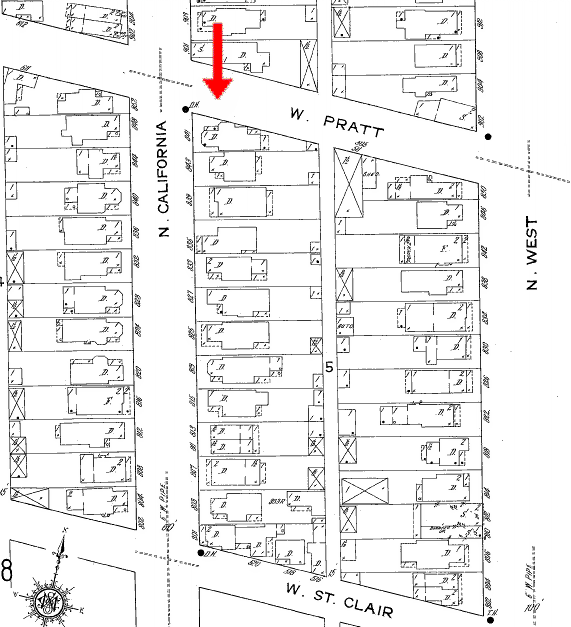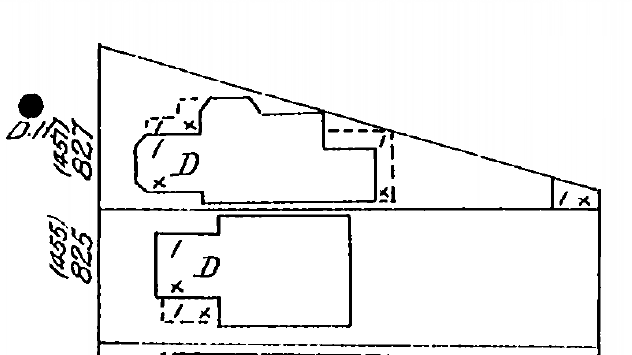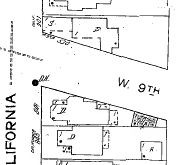|
|
|
|
| In 1910 a newcomer to Indianapolis placed an ad in the Indianapolis Recorder. Her advertisement boldly announced that "Mme. C.J. Walker of Pittsburgh, Pa., THE NOTED HAIR CULTURIST, is in this city at the residence of Dr. J.H. Ward at 722 Indiana Avenue, where she will demonstrate the art of growing hair." Many people flocked to Madam Walker's temporary salon, and Walker was soon able to rent a room on North West Street, near where she would eventually establish one of the nation's most prosperous ventures. However Madam Walker remained close to Joseph and Zella Ward, with Joseph Ward serving as Walker's personal physician until her death in 1919. | Summer reports |
In Summer 2004 the IUPUI Archaeology Field School will conduct its fifth season of excavations in Indianapolis' near-Westside. The field school will examine a house on California Street that was home to White Hoosiers, a Bethel AME Pastor, the Secretary of the local Colored YMCA, and Joseph and Zella Ward. The Wards were simply one in a string of families that called the house home over more than a century, and the African Americans who lived in the home after 1915 were typical of the families that made their homes along California Street's 800 block. Well-educated, well-connected, ambitious and enterprising, the families at 847 North California were among Black Indianapolis' most prominent citizens despite the overwhelming boundaries placed before them. However the Beltz family that called the residence home between 1890 and 1915 was also typical of the many working-class White Hoosier households that once populated most of the near-Westside, only to leave during a period of rapid racial segregation through the area that included California Street.
| Right: When the 1914 Sanborn Insurance map was completed, 847 North California (at the red arrow) was neighbored by structures in nearly every lot, and most of the Beltz's neighbors in 1914 were African American. Click the thumbnail below for a larger image. |  |
Once an expansive neighborhood with numerous ethnic and class lines, the Ransom Place Historic District is today the sole surviving remnant of the thousands of homes that dotted the near-Westside after about 1850 into the 1980's. Our project's central interest is in how material culture reflects near-Westside residents' vast range of multicultural identities: that is, can we really "see" ethnic and racial distinctions in everyday material consumption? How can archaeology examine and illuminate the development of a multicultural community in the late-nineteenth century, how can we document its subsequent segregation into strict racially defined neighborhoods beginning around 1910, and what we might we have to say about the social and material processes that removed these neighborhoods from the contemporary cityscape? Even today, some Indianapolis residents are prone to characterize places like the near-Westside in monolithic terms, seeing these places as universally "Black," "White," or otherwise "ethnic" neighborhoods. There is some truth to this, but it masks a vast range of social complexity across cultural, class, and color lines; at its worst, it suggests that contemporary divisions between rich and poor, European and Hoosier, or Black and White are timeless phenomena that have always existed in Indianapolis. Archaeological material culture tells much more complex stories about similarities and vast disparities in the lives of individuals and neighborhoods across lines of difference.
Like most homes in the near-Westside, the earliest residents of 847 California Street were White Hoosiers. The home was built in 1890 and first appears in the city directories in 1891 as the home of Frank P. and Eva (Evalyn) Beltz. Born in 1853, Frank P. Beltz first appeared in an Indianapolis city directory in 1868, when he was a bellboy at a local hotel where he and his father (a news dealer) were boarders. Beltz was born in Pennsylvania, as were both his parents, and Evalyn was born in Indiana to an Indiana-born mother and a German-born father. In 1872 Frank first appeared in the directory as a blacksmith, when he was living at 175 Stevens Alley with Jacob Beltz and Harry A Beltz. Jacob was a plasterer and Harry was a merchant policeman, and they were likely Frank's brothers. In 1873 Frank appeared as the proprietor of carriage maker Swain, Black, and Company, and through the remainder of his life he would appear in the directories as either a blacksmith or carriage maker. Frank and wife Evalyn lived on South Noble, South Alabama, South East, and East Vermont Streets between the mid-1870's and mid-1880's, none of which are on the near-Westside. Between 1885 and 1890 Frank first moved to the near-Westside when his family settled at 187 West New York Street and Frank appeared as a carriage maker with a shop at 79 West Market Street. He continued to manage a shop on West Market after moving to California Street in 1891, when his son Frank Raymond Beltz was also a carriage maker living with his parents. In 1897 the two co-managed an operation that billed itself as FP Beltz and Son: The firm produced carriages at a West Market street shop and also sold cigars at 29 South Illinois Street under the same business name.
 |
The Beltz family remained on California Street during the period when it rapidly became a predominately Black neighborhood. In 1910, for instance, two-thirds of the neighborhood’s residents were African American, as compared to 14% in 1900. When the census inventory was taken in 1900 it found Frank, Eva, daughter Geneva (born1894), son Arthur (born 1897) and daughter Gladys (born 1900). By 1910 the Beltz's would have had many African-American neighbors along North California, when two-thirds of Ransom Place's residents were Black or Mulatto. |
| Above: The 1898 Sanborn insurance map showed Frank and Eva Beltz's home at the corner of California and 9th Street, when the house was numbered as 827 North California Street. |
Frank P. Beltz last appeared in the city directory in 1915, when he was still a blacksmith and Frank and Eva's household included son Arthur, a clerk, and daughter Geneva, a stenographer. After Frank's death in May, 1915, his family moved out of the near-Westside, among the final White families to live in the 800 block of California Street. While some neighborhoods to the south would remain White Hoosier or European immigrant areas more than a half-century later, the neighborhoods closest to Indiana Avenue shifted quite rapidly beginning about 1900. By the early twentieth century, the community along Indiana Avenue became home to many African Americans. These residents were part of the "Great Migration" fleeing Jim Crow racism and searching for improved material and social opportunities in the north and Midwest. Most of these earliest Black arrivals from the Upper South moved into the neighborhoods along Indiana Avenue, and later arrivals into the Depression moved into neighborhoods south of Ransom Place across what is now the IUPUI campus.
| Settlement patterns in the Ransom Place neighborhood illustrate how the blocks surrounding Indiana Avenue were settled by the first wave of migrating African Americans. In 1880, a rather modest 46 (9.1%) of 503 Ransom Place residents were classed as Black or Mulatto, and in 1900 105 (14.2%) of the neighborhood’s 740 residents were Black or Mulatto. Between 1900 and 1910 a significant wave of migrants from the Upper South arrived in Indianapolis, and in 1910 469 of Ransom Place’s 707 residents were Black or Mulatto (66.4%). The demographic transition was complete by 1920, when 96% of the residents were Black. | Right: In 1950 the home at California and 9th Street was not significantly changed from when it was first built 60 years earlier. The major change had been the addition of a cinder block garage at the rear of the lot that still stands today. |  |
A series of African-American households rapidly occupied the California Street home in the four years after the Beltz family moved. The new residents’ social prominence in Black Indianapolis foreshadowed the African-American elite who would call the 800 block home after World War I. In 1916 Thomas E. Taylor, secretary of the Colored YMCA, became the home’s first African-American resident. A year later he was followed by Agnes Walker, a masseuse. In 1918 Charles Sumner Williams, Pastor of Bethel AME Church, moved to the home. In 1919, physician Joseph H. Ward moved to the California Street home. The Wards moved in 1922 and were replaced by Walter and Blanche Ewing. Walter ran a clothes cleaning business on North West Street and then Indiana Avenue, and his family remained into the home until 1940. This swath of residents included entrepreneurs, professionals, and representatives of the city’s most prominent Black church, the important YMCA, and Madam Walker’s own personal physician.
| Like his most famous patient and many of the African-American entrepreneurs in his Indianapolis neighborhood, Joseph Henry Ward was accomplished, successful, and nationally known. Nevertheless, in many ways Ward's life history is much like those of many African-American Hoosiers who came to call Indianapolis' near-Westside home in the late-nineteenth and early twentieth century. The North Carolina-born Joseph Henry Ward came to Indianapolis between 1880 and 1890, when he was a servant and then a driver before entering Indiana Medical College. Ward graduated in about 1897 and and opened an office on Indiana Avenue by 1898. His wife Zella Louise Locklear Ward was among the founders of the Women's Improvement Club, an organization that set up a tuberculosis camp around 1905. Around the time Madam Walker arrived in Indianapolis, Joseph Ward became the proprietor of Ward's Sanitarium, Indianapolis' first Black hospital, and when Ward joined the Army in World War I he became the Army's highest-ranking African-American officer. Like many of his neighbors on California Street, Ward was a member of Bethel AME, and the California Street home's previous occupant Charles Sumner Williams was the church's Pastor. In 1924 Ward accepted a position as the administrator of the Tuskegee Veteran's Hospital, where he remained for 12 years before returning to Indianapolis. Zella Ward passed away in 1954 and her husband joined her at Crown Hill Cemetery two years later. |
|
| Above: Joseph Henry Ward posed for this picture while he was stationed in France; from Scott's Official History of the American Negro in the World War (1919). |
Excavation reports on the field school will be posted on this page as the summer progresses, beginning with the May 21 Field School report and continuing June 12. For more details on the course, visit the Field School syllabus.
All field excavation at the site will be conducted by students enrolled in the IUPUI Archaeology Field School, which we offer each Summer somewhere in the near-Westside. The Archaeology Field School (Anthropology P405) is open to any undergraduate student for four to six credits. Graduate credit and/or graduate research opportunities can be arranged with the instructor. You do not need to be an Anthropology student or have any archaeological coursework or experience to enroll in the course. Students will be trained in field excavation methodology, public interpretation, laboratory analysis, and archaeological theory. Students learn to identify nineteenth- and twentieth-century material culture, excavate historic-period urban sites, and work actively with many visitors and our partners in the Ransom Place Neighborhood Association. Full information on course requirements can be found in the Field School syllabus. For registration details, enrolled IUPUI students can contact the Registrar's Office or visit Insite. Visiting students can get details on credit transfer on the Visiting Students page. Students registered for six credits attend the class each weekday from 8:30 to 3:00; four-credit students attend three days a week.
Volunteers are welcome to work alongside field school students. You can volunteer for as many days as you like; we prefer to have volunteers call ahead, and it works best to spend a whole or nearly whole excavation day on site. Volunteers younger than 16 should be accompanied by a parent or adult. If you would like to volunteer but do not want to dig, we will also maintain our lab during the field season in Cavanaugh Hall, where recently excavated artifacts will be washed as they come in from the field. If you would like to volunteer over the summer or have questions, please email Paul Mullins (paulmull@iupui.edu) for details.
Page last updated June 12, 2004